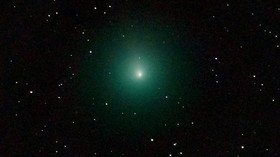Green balls of fire! Comet to light up sky in closest pass for the next 20 years (VIDEOS)

As the Geminid meteor shower reaches its peak another celestial firecracker is inbound, making its closest approach to the Earth for the next 20 years and adding a festive greenish hue to the weekend’s skies.
The annual Geminid meteor shower is the last, and strongest, meteor shower of the year. It will shoot green fireballs across the skies on Friday. Most meteors will be visible in the North American sky, peaking about 7:30am ET Friday, reaching a maximum of about 100 per hour before dropping off to an average of 30 to 40 per hour into the weekend.
Also on rt.com Star attraction: How to catch the biggest meteor shower of the yearThe grand finale of the cosmic pyrotechnics display to see out 2018 will be the Comet 46P/Wirtanen, which is making its closest approach to Earth (within 7 million miles) for the next 20 years, peaking on Sunday, in one of the best and brightest near-Earth passes by a comet in four centuries.
Unfortunately, the full moon will act as somewhat of a party pooper, adding a bit of lunar noise that will make the comet’s greenish hue a little more difficult to see in all its glory, despite it being the brightest comet visible in 2018.
Great shot of comet 46P/Wirtanen AND a meteor thanks to our friend Michael Reagan in Fort Mohave, AZ!Charts, tips and other info on how to see 2018’s brightest comet: https://t.co/sxjVTku1kKpic.twitter.com/y2IbrqjBGI
— EarthSky (@earthskyscience) December 13, 2018
“It’s not expected to have a big spectacular tail; it’s going to be a smear,” Matthew J. Holman, senior astrophysicist and director of the Minor Planet Center at the Harvard-Smithsonian Center for Astrophysics told AccuWeather.
“It may not be obvious to people what they are seeing, and they may need to use what we call averted vision, meaning you don’t look right at the thing, but you look away from it and look in your peripheral vision.”
See it! Images of comet 46P/Wirtanen. ☄️ This is comet 46P/Wirtanen as seen on November 26, 2018 in Namibia.Photo via Gerald Rhemann. 📸See more photos: https://t.co/bQvkX5JMzpGerald's website: https://t.co/lX9hzUZGrcpic.twitter.com/F8hZ8MfrSe
— EarthSky (@earthskyscience) December 10, 2018
Comet 46P/Wirtanen, which passes near the Earth roughly every five and a half years will be at its best on Sunday, December 16. The current, most optimistic projections consider Comet 46P/Wirtanen at a magnitude 3, just slightly brighter than the dimmest star in the Big Dipper.
It will be difficult to spot without a telescope or binoculars, especially for those in urban areas.
Also on rt.com Comet set for its closest flyby of Earth in 4 centuries: What you need to knowThe comet is less than a mile across, and pales in comparison to its famous contemporaries such as Halley’s Comet and Hale-Bopp. You can check here to find out when the best viewing time in your area will be over the weekend.
The next comet to make such a close approach to Earth will be 249P/LINEAR 53 on Nov. 4, 2029.
Like this story? Share it with a friend!














